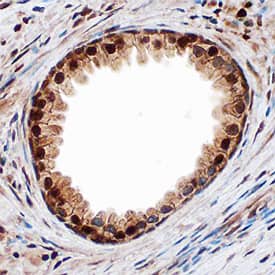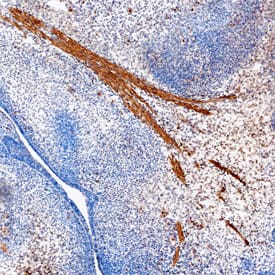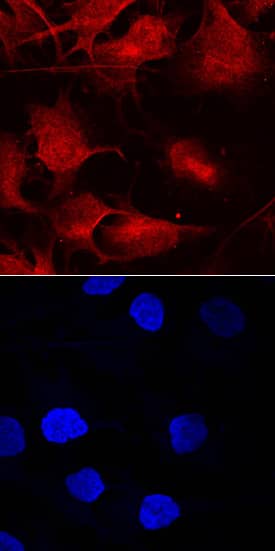Human/Mouse Smad9 Antibody
R&D Systems, part of Bio-Techne | Catalog # AF7215

Key Product Details
Species Reactivity
Applications
Label
Antibody Source
Product Specifications
Immunogen
Ala158-Ser223
Accession # O15198
Specificity
Clonality
Host
Isotype
Scientific Data Images for Human/Mouse Smad9 Antibody
Smad9 in A172 Human Cell Line.
Smad9 was detected in immersion fixed A172 human glioblastoma cell line using Sheep Anti-Human/Mouse Smad9 Antigen Affinity-purified Polyclonal Antibody (Catalog # AF7215) at 10 µg/mL for 3 hours at room temperature. Cells were stained using the NorthernLights™ 557-conjugated Anti-Sheep IgG Secondary Antibody (red, upper panel; Catalog # NL010) and counterstained with DAPI (blue, lower panel). Specific staining was localized to cytoplasm. View our protocol for Fluorescent ICC Staining of Cells on Coverslips.Smad9 in Human Prostate Cancer Tissue.
Smad9 was detected in immersion fixed paraffin-embedded sections of human prostate cancer tissue using Sheep Anti-Human Smad9 Antigen Affinity-purified Polyclonal Antibody (Catalog # AF7215) at 3 µg/mL overnight at 4 °C. Before incubation with the primary antibody, tissue was subjected to heat-induced epitope retrieval using Antigen Retrieval Reagent-Basic (Catalog # CTS013). Tissue was stained using the Anti-Sheep HRP-DAB Cell & Tissue Staining Kit (brown; Catalog # CTS019) and counterstained with hematoxylin (blue). Specific staining was localized to nuclei in glandular epithelial cells. View our protocol for Chromogenic IHC Staining of Paraffin-embedded Tissue Sections.Smad9 in Mouse Embryo.
Smad9 was detected in immersion fixed frozen sections of mouse embryo (13 d.p.c.) using Sheep Anti-Human Smad9 Antigen Affinity-purified Polyclonal Antibody (Catalog # AF7215) at 1.7 µg/mL overnight at 4 °C. Tissue was stained using the Anti-Sheep HRP-DAB Cell & Tissue Staining Kit (brown; Catalog # CTS019) and counterstained with hematoxylin (blue). Specific staining was localized to developing muscle cells. View our protocol for Chromogenic IHC Staining of Frozen Tissue Sections.Applications for Human/Mouse Smad9 Antibody
Immunocytochemistry
Sample: Immersion fixed A172 human glioblastoma cell line
Immunohistochemistry
Sample: Immersion fixed paraffin-embedded sections of human prostate cancer tissue and immersion fixed frozen sections of mouse embryo (13 d.p.c.)
Reviewed Applications
Read 1 review rated 3 using AF7215 in the following applications:
Formulation, Preparation, and Storage
Purification
Reconstitution
Formulation
Shipping
Stability & Storage
- 12 months from date of receipt, -20 to -70 °C as supplied.
- 1 month, 2 to 8 °C under sterile conditions after reconstitution.
- 6 months, -20 to -70 °C under sterile conditions after reconstitution.
Background: Smad9
SMAD9 (SMA protein and Mothers Against Decapentaplegic 9; also SMAD8 and MAHD6) is a 55-60 kDa R-Group member of the dwarfin/SMAD family of proteins. It is expressed by BMP-responsive cells, and serves to transmit information from the BMP receptor (BMPR) to the nucleus. In particular, following BMPR activation, SMAD9 is phosphorylated by the BMPR on its C-terminus, promoting heterodimerization with SMAD4 and its translocation into the nucleus. Here, SMAD9 binds to DNA and participates in gene activation. Human SMAD9 is 467 amino acids (aa) in length. It contains a DNA-binding domain termed MH1 (aa 16-140) plus a receptor/transcription factor binding domain termed MH2 (aa 273-467). The C-terminus contains two phosphorylation sites at Ser465 and Ser467. There is one splice form that shows a deletion of aa 224-260. Over aa 158-223, human and mouse SMAD9 share 82% identy in amino acid sequence.
Long Name
Alternate Names
Gene Symbol
UniProt
Additional Smad9 Products
Product Documents for Human/Mouse Smad9 Antibody
Product Specific Notices for Human/Mouse Smad9 Antibody
For research use only


